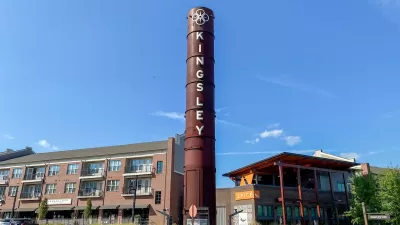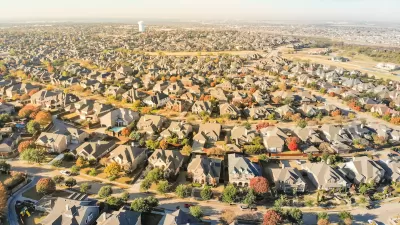With more people moving away from central cities, we have the chance to avoid past mistakes and redesign the American suburb to be less car-centric and more diverse.

What if we reinvent the suburbs to be more sustainable? That’s what Addison Del Mastro asks in a recent piece on Vox. Del Mastro argues that, with remote work changing the nature of commuting and more millennials looking to buy homes, now is the time to reenvision what suburban life could look like and write a “second draft” that’s better than the first.
“The demand for something like urban living is real. Even at the outer edges of growing metro areas, mixed-use walkable developments pop up alongside familiar subdivisions and McMansions.” Indeed, “Between 2019 and 2020, the share of millennials who live in suburbs increased by 4 percentage points; and in 2014, more than 60 percent of immigrants lived in suburbs, up from just over half in 2000.”
As Del Mastro has written before, immigrant communities are transforming the strip mall and other suburban spaces to accommodate different uses and culturally relevant services. “The ongoing diversification of the suburbs is coinciding with the appearance of New Urbanist, mixed-use development there, and the renewed interest in suburban living following the pandemic. The makings of a suburban transformation are here.”
As Del Mastro points out, “Zoning codes were not really meant to be perpetual; master plans were supposed to guide their evolution over the decades, planning for and accommodating growth.” It’s time for the suburbs to embrace change, and for planners to recognize their potential to transform into more walkable, sustainable, and diverse communities.
FULL STORY: What if the suburbs were just a first draft?

Alabama: Trump Terminates Settlements for Black Communities Harmed By Raw Sewage
Trump deemed the landmark civil rights agreement “illegal DEI and environmental justice policy.”

Planetizen Federal Action Tracker
A weekly monitor of how Trump’s orders and actions are impacting planners and planning in America.

The 120 Year Old Tiny Home Villages That Sheltered San Francisco’s Earthquake Refugees
More than a century ago, San Francisco mobilized to house thousands of residents displaced by the 1906 earthquake. Could their strategy offer a model for the present?

In Both Crashes and Crime, Public Transportation is Far Safer than Driving
Contrary to popular assumptions, public transportation has far lower crash and crime rates than automobile travel. For safer communities, improve and encourage transit travel.

Report: Zoning Reforms Should Complement Nashville’s Ambitious Transit Plan
Without reform, restrictive zoning codes will limit the impact of the city’s planned transit expansion and could exclude some of the residents who depend on transit the most.

Judge Orders Release of Frozen IRA, IIJA Funding
The decision is a victory for environmental groups who charged that freezing funds for critical infrastructure and disaster response programs caused “real and irreparable harm” to communities.
Urban Design for Planners 1: Software Tools
This six-course series explores essential urban design concepts using open source software and equips planners with the tools they need to participate fully in the urban design process.
Planning for Universal Design
Learn the tools for implementing Universal Design in planning regulations.
Clanton & Associates, Inc.
Jessamine County Fiscal Court
Institute for Housing and Urban Development Studies (IHS)
City of Grandview
Harvard GSD Executive Education
Toledo-Lucas County Plan Commissions
Salt Lake City
NYU Wagner Graduate School of Public Service





























